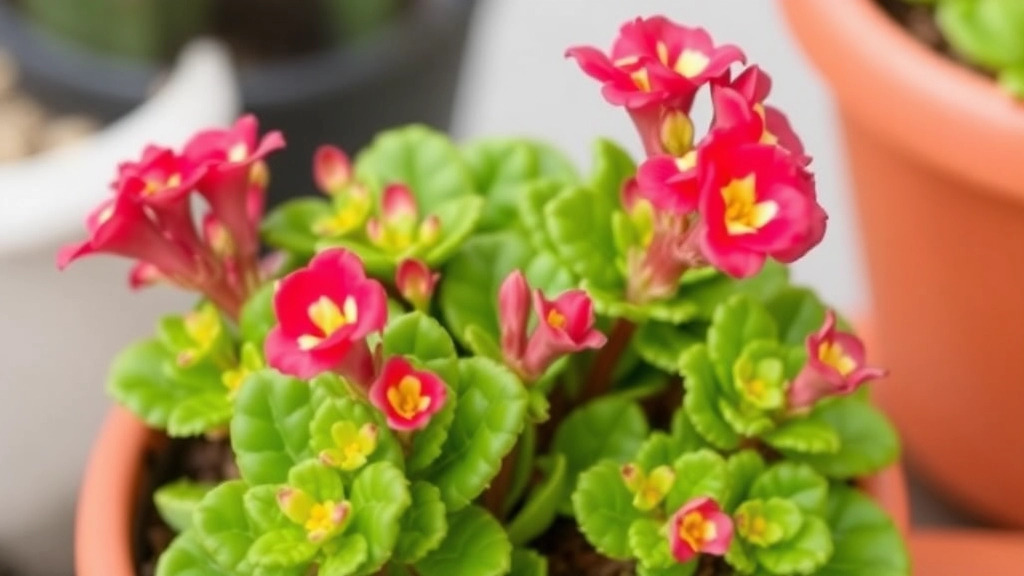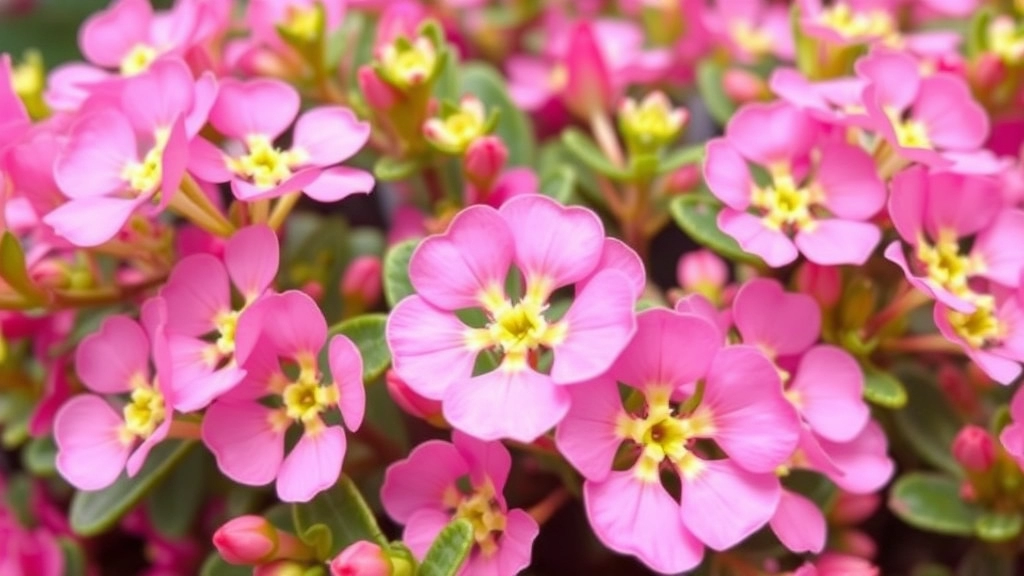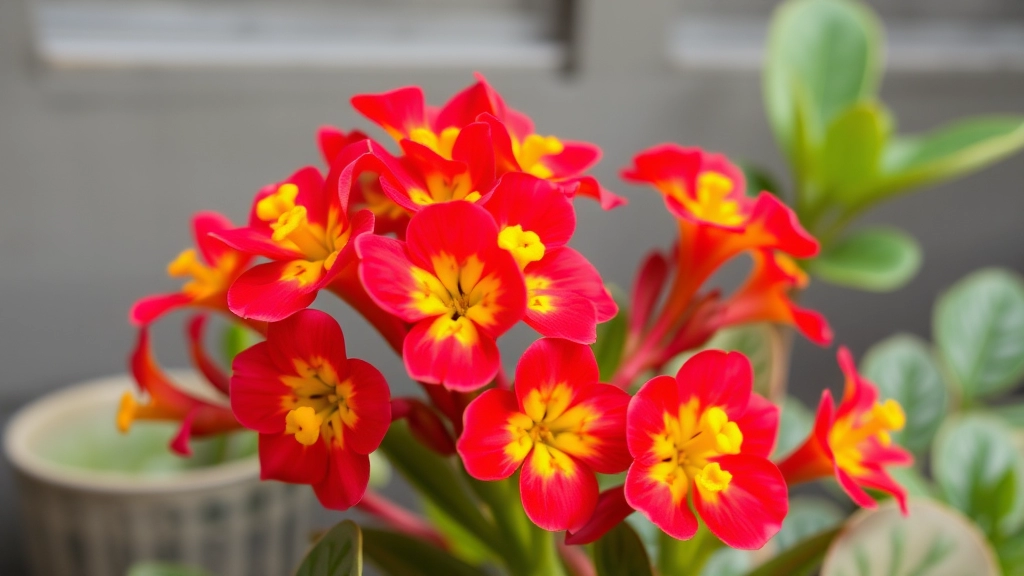Flowering Kalanchoe Pictures
Flowering Kalanchoe Pictures are a feast for the eyes, especially if you’re a plant enthusiast like me. Whether you’re looking to identify different types of Kalanchoe species or seeking inspiration for your garden, these vibrant blooms offer endless possibilities. From their unique shapes to their stunning colors, Kalanchoe flowers can transform any space into a botanical paradise.
Importance of Care
But it’s not just about the aesthetics. Understanding the care and maintenance of these succulents is crucial for keeping them healthy and vibrant. From ideal lighting and watering conditions to propagation tips, knowing how to care for your flowering Kalanchoe can make all the difference.
Exploring Kalanchoe
So, let’s dive into the world of Kalanchoe and explore the beauty and care of these fascinating plants.
Popular Flowering Kalanchoe Varieties and Their Unique Traits
When considering flowering plants for your home or garden, Kalanchoe is often at the top of the list.
These vibrant plants not only bring colour but also offer a range of unique traits that make them stand out.
Key Varieties of Flowering Kalanchoe
- Kalanchoe blossfeldiana
- Description: Known for its clusters of small, brightly-coloured flowers, this variety is a favourite among indoor gardeners.
- Traits: It blooms in a variety of colours, including red, pink, yellow, and white, making it versatile for any decor.
- Kalanchoe tomentosa (Panda Plant)
- Description: This variety features fuzzy, grey-green leaves adorned with brown edges.
- Traits: While it is less known for its flowers, when it does bloom, the small, tubular flowers are a delightful surprise.
- Kalanchoe luciae (Flapjack Plant)
- Description: Recognised for its large, flat, paddle-like leaves that turn a stunning red in bright light.
- Traits: Its flowers are less prominent but add a unique touch to its overall appearance.
- Kalanchoe beharensis (Chandelier Plant)
- Description: This variety has large, thick leaves and a distinctive branching structure.
- Traits: Its flowers are less frequent but can be quite striking when they appear.
Why Choose Kalanchoe?
- Low Maintenance: Kalanchoe varieties are generally easy to care for, making them perfect for beginners.
- Long Blooming Period: Many varieties can bloom for several months, providing continuous colour.
- Versatility: Suitable for both indoor and outdoor settings, they adapt well to different environments.
For more detailed information on how to care for these beautiful plants, check out our flowering Kalanchoe care tips and our comprehensive guide to Kalanchoe blossfeldiana hybrid care.
A Visual Guide to Colorful Kalanchoe Blooms

Have you ever wandered into a garden centre and been mesmerised by the vibrant hues of Kalanchoe flowers?
These beauties come in a variety of colours that can brighten up any space.
Let’s dive into some of the most popular varieties and their unique traits that make them stand out.
Popular Kalanchoe Varieties
- Kalanchoe Blossfeldiana
- Traits: Known for its clusters of small flowers, it blooms in shades like red, pink, yellow, and white.
- Why It’s Great: Perfect for adding a pop of colour to your indoor space.
- Kalanchoe Tomentosa (Panda Plant)
- Traits: This variety features fuzzy, grey-green leaves with a hint of red at the edges, and it occasionally blooms with yellow flowers.
- Why It’s Great: Its unique texture adds an interesting element to your plant collection.
- Kalanchoe Luciae (Flapjack Plant)
- Traits: Known for its large, flat leaves that turn a stunning red in bright sunlight, it produces small yellow flowers.
- Why It’s Great: An eye-catching succulent that’s sure to grab attention.
- Kalanchoe Marmorata (Pencil Plant)
- Traits: This variety has striking green leaves with marbled patterns and small pink flowers.
- Why It’s Great: Its decorative foliage makes it a standout even when it’s not in bloom.
Why You’ll Love Kalanchoe
- Long-Lasting Blooms: Once they start blooming, Kalanchoe flowers can last for weeks, bringing joy throughout the seasons.
- Versatile Decor: Whether you want to spruce up your home or your garden, these plants fit right in.
### Best Care Practices for Flowering Kalanchoe Plants
Caring for flowering Kalanchoe can seem daunting, but with the right practices, you can enjoy vibrant blooms year-round.
#### Understanding Flowering Kalanchoe Needs
Do you ever wonder why your Kalanchoe isn’t flowering as much as you’d like? Here are some essential care tips to keep your plant healthy and thriving:
– **Soil Requirements**: Use a well-draining potting mix. A cactus or succulent mix works best. This prevents root rot, a common issue for Kalanchoe.
– **Watering Wisely**: Allow the top inch of soil to dry out between waterings. Overwatering can lead to wilted leaves and poor growth. A good rule of thumb is to water thoroughly, then wait until the soil is dry before watering again.
– **Fertilisation**: Feed your Kalanchoe with a balanced liquid fertiliser every 4-6 weeks during the growing season (spring and summer). This encourages blooming and overall health.
– **Pruning**: After flowering, trim back spent blooms and any leggy growth. This not only keeps your plant looking tidy but also encourages new growth.
– **Temperature and Humidity**: Kalanchoe thrives in temperatures between 18-24°C. Avoid placing it near cold drafts or heat sources.
#### Light Conditions
Lighting is crucial for blooming Kalanchoe.
– **Bright Indirect Light**: Place your plant in a spot where it receives bright, indirect sunlight. Too much direct sun can scorch its leaves, while too little light can hinder blooming.
– **Rotate Regularly**: Rotate your plant every few weeks to ensure even growth and exposure to light.
If you’re interested in more detailed guidance, check out our comprehensive [flowering Kalanchoe care tips](https://planthq.org/flowering-kalanchoe-care-tips-for-thriving-blooms/). And if you’re curious about why your Kalanchoe might not be flowering, you can find useful insights in our article on [top reasons and fixes for non-flowering Kalanchoe](https://planthq.org/why-is-my-kalanchoe-not-flowering-top-reasons-and-fixes/).
How to Propagate Flowering Kalanchoe from Cuttings

If you’ve ever admired the vibrant blooms of flowering Kalanchoe and wondered how to grow more of these stunning plants, you’re in luck. Propagating Kalanchoe from cuttings is a straightforward process that can yield beautiful results.
Why Propagate from Cuttings?
Many plant enthusiasts prefer propagation from cuttings because it’s:
- Cost-effective: Create new plants without purchasing more.
- Quick: You can see results in a matter of weeks.
- Satisfying: There’s a sense of accomplishment in nurturing new growth.
Steps to Propagate Flowering Kalanchoe
- Select a Healthy Stem:
- Look for a healthy, non-flowering stem.
- Choose one that’s at least 4-6 inches long.
- Make the Cut:
- Use clean, sharp scissors or pruning shears.
- Cut just below a leaf node, as this is where roots will develop.
- Prepare the Cutting:
- Remove the lower leaves, leaving a few at the top.
- This helps prevent rot when placed in soil.
- Allow to Callous:
- Place the cutting in a dry, warm area for 1-2 days.
- This allows the cut end to callous over, reducing the risk of rot.
- Plant the Cutting:
- Fill a small pot with well-draining soil.
- Insert the cutting into the soil, ensuring the calloused end is buried.
- Water Sparingly:
- Lightly water the soil to settle it around the cutting.
- Avoid overwatering; too much moisture can lead to rot.
- Create a Humid Environment:
- Cover the pot with a plastic bag or a clear plastic dome.
- This helps retain moisture while the cutting establishes roots.
- Provide Proper Light:
- Place the pot in a bright, indirect light location.
- Avoid direct sunlight, which can scorch the cutting.
- Monitor Growth:
- After a few weeks, gently tug on the cutting.
- If you feel resistance, roots have formed.
- Transplant When Ready:
- Once roots are established, transplant into a larger pot.
- Continue caring for your new Kalanchoe as you would for an adult plant.
Are you struggling to keep your flowering Kalanchoe vibrant and blooming?
Understanding the ideal lighting and watering conditions is essential for nurturing these beautiful plants.
### Optimal Lighting for Kalanchoe
Kalanchoe thrives in bright, indirect light. Here’s what you need to know:
– **Sunlight Exposure**: Place your Kalanchoe near a window where it can receive plenty of natural light, ideally for about 6 hours a day.
– **Avoid Direct Sun**: While they love light, direct sunlight can scorch the leaves. A sheer curtain can help diffuse harsh rays.
– **Signs of Insufficient Light**: If your Kalanchoe becomes leggy or its blooms are sparse, it’s likely not getting enough light.
### Watering Techniques for Healthy Growth
Watering is another critical factor for the health of your Kalanchoe. Follow these guidelines:
– **Soil Moisture**: Allow the top inch of soil to dry out between waterings. This prevents root rot, a common issue for Kalanchoe.
– **Watering Frequency**: Typically, watering every 2-3 weeks is sufficient, but this may vary based on your home’s humidity and temperature.
– **Drainage**: Ensure your pot has drainage holes. Excess water should be able to escape easily.
By keeping an eye on these lighting and watering conditions, you can ensure your Kalanchoe not only survives but flourishes. For more detailed guidance, check out our [flowering Kalanchoe care tips](https://planthq.org/flowering-kalanchoe-care-tips-for-thriving-blooms/) and learn how to [make your Kalanchoe flower again](https://planthq.org/how-to-make-your-kalanchoe-flower-again/).
Preventing Common Pests and Issues in Flowering Kalanchoe

Have you ever noticed your beautiful Kalanchoe starting to look a bit off? It’s a common worry for plant lovers.
Flowering Kalanchoe can be prone to a few pesky pests and issues that can dampen their vibrant blooms.
Common Pests
- Aphids: Tiny green bugs that suck out the plant’s juices.
- Mealybugs: White, cottony pests that love to hide in leaf joints.
- Spider Mites: These little guys create webs and can cause leaves to yellow.
How to Spot Problems
- Yellowing Leaves: Could be a sign of pests or overwatering.
- Wilting: Often indicates underwatering or root rot.
- Webbing: A clear sign of spider mites at work.
Prevention Tips
- Regular Checks: Inspect your Kalanchoe weekly.
- Clean Leaves: Wipe down leaves with a damp cloth to remove dust and pests.
- Neem Oil: A natural remedy that works wonders against pests. Just spray it on affected areas.
Quick Fixes
- Soap Solution: Mix mild soap with water and spray on affected areas.
- Isolate: If you spot pests, move the plant away from others to prevent spreading.
By staying vigilant and taking these simple steps, you can keep your Kalanchoe thriving and free from common issues.
When considering how to enhance your living space or garden, flowering Kalanchoe offers an array of possibilities. These vibrant plants not only brighten up any area but also add a touch of elegance and charm.
### Indoor Decoration Ideas
– **Table Centerpieces:** Place a pot of flowering Kalanchoe in the middle of your dining or coffee table. The colourful blooms create an inviting atmosphere.
– **Windowsills:** Kalanchoe thrives in bright light, making it perfect for windowsills. The cheerful flowers can transform an ordinary space into a lively one.
– **Shelving Units:** Use Kalanchoe plants on shelves to create visual interest. Their varied heights and colours can add depth to your decor.
– **Office Spaces:** A flowering Kalanchoe on your desk can boost your mood and productivity. Its low maintenance nature makes it an ideal choice for busy professionals.
### Outdoor Decoration Ideas
– **Garden Borders:** Plant Kalanchoe along garden edges to create a striking border. Their vibrant hues can contrast beautifully with green foliage.
– **Patio Displays:** Group Kalanchoe pots of different colours on your patio. This arrangement can create a lively outdoor seating area.
– **Hanging Baskets:** Consider using Kalanchoe in hanging baskets. They can cascade beautifully, adding vertical interest to your garden.
– **Event Decor:** Use flowering Kalanchoe for outdoor gatherings. They can serve as centrepieces or accents, bringing joy to any occasion.
### Tips for Effective Use
– **Mix and Match:** Pair Kalanchoe with other plants for a diverse look. Combining different textures and colours can create a stunning display.
– **Seasonal Changes:** Rotate your Kalanchoe with seasonal blooms to keep your decor fresh and exciting.
– **Care Considerations:** Remember to assess the light and watering needs of your Kalanchoe, whether indoors or outdoors. This ensures they remain vibrant and healthy. For more detailed tips, check out our [complete care guide for Kalanchoe Tubiflora](https://planthq.org/complete-care-guide-for-kalanchoe-tubiflora-mother-of-millions/).
If you’re looking for specific advice on propagation, our [step-by-step guide on how to propagate Kalanchoe Tomentosa](https://planthq.org/how-to-propagate-kalanchoe-tomentosa-stepbystep-guide/) can provide you with all the information you need.
FAQs on Flowering Kalanchoe Pictures
What are some popular varieties of Kalanchoe?
Some popular varieties include:
- Kalanchoe Blossfeldiana: Known for its clusters of small flowers in shades like red, pink, yellow, and white.
- Kalanchoe Tomentosa (Panda Plant): Features fuzzy, grey-green leaves with red edges and occasionally blooms with yellow flowers.
- Kalanchoe Luciae (Flapjack Plant): Known for large, flat leaves that turn red in bright sunlight and produce small yellow flowers.
- Kalanchoe Marmorata (Pencil Plant): Has striking green leaves with marbled patterns and small pink flowers.
Why should I consider growing Kalanchoe?
Kalanchoe plants are loved for their long-lasting blooms and their ability to serve as versatile decor, suitable for both indoor and outdoor spaces.
How can I propagate Kalanchoe from cuttings?
Propagating Kalanchoe from cuttings involves several steps including selecting a healthy stem, making a clean cut, allowing the cut end to callous, and planting the cutting in well-draining soil. For detailed steps, refer to the propagation guide above.
What are the common pests that affect Kalanchoe?
Common pests include:
- Aphids: Tiny green bugs that suck out the plant’s juices.
- Mealybugs: White, cottony pests that hide in leaf joints.
- Spider Mites: Create webs and can cause leaves to yellow.
How can I spot problems in my Kalanchoe plant?
Look for signs such as:
- Yellowing Leaves: Could indicate pests or overwatering.
- Wilting: Often a sign of underwatering or root rot.
- Webbing: Indicates the presence of spider mites.
What are some prevention tips to keep my Kalanchoe healthy?
To prevent common issues:
- Regular Checks: Inspect your Kalanchoe weekly.
- Clean Leaves: Wipe down leaves with a damp cloth to remove dust and pests.
- Neem Oil: Spray it on affected areas to combat pests.
What quick fixes can I use if my Kalanchoe has pests?
Quick fixes include:
- Soap Solution: Mix mild soap with water and spray on affected areas.
- Isolate: Move the plant away from others to prevent pest spread.
References
-
Kalanchoe Plant Care: How To Grow A Flowering Kalanchoe
-
How to Grow Kalanchoe Succulents
-
Kalanchoe: How to Grow and Care for Kalanchoe Plants
